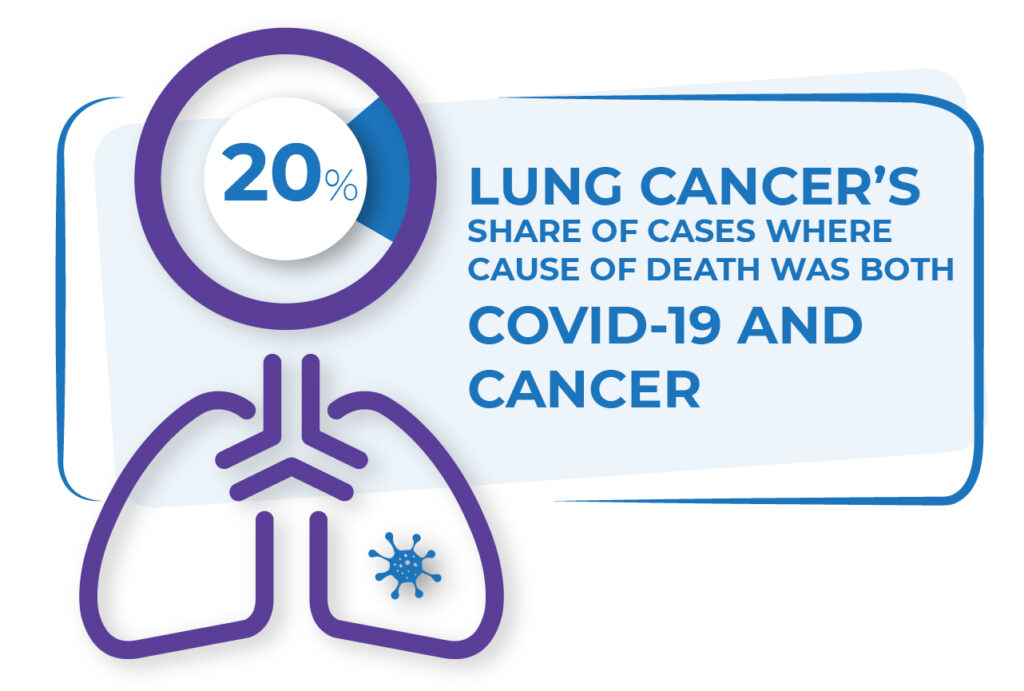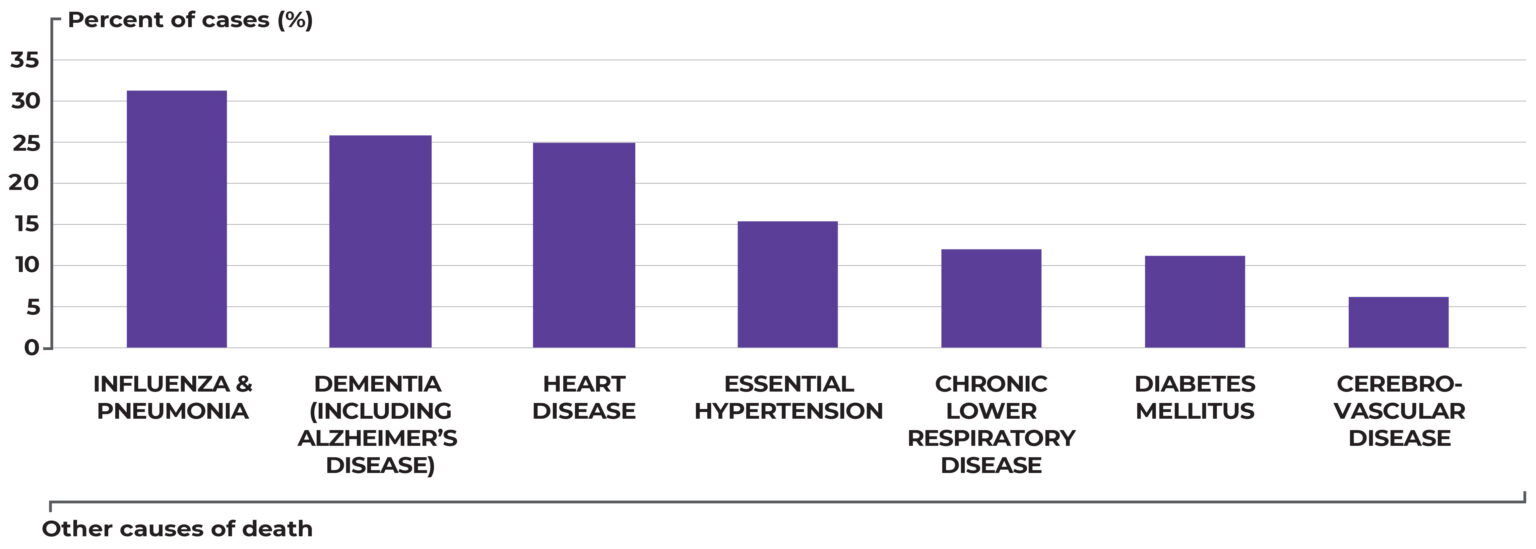Road to recovery: Cancer in the COVID-19 era
Impacts on cancer mortality
In addition to looking at the number of newly diagnosed cases of cancer (incidence), the month-to-month trends in cancer deaths (mortality) are another strong indicator of how much progress is being made in the fight against cancer. But during the first and second waves of the pandemic, both COVID-19 and cancer were listed as the joint cause of death for many people, making it difficult to get an accurate picture of cancer’s impact on mortality across Canada during this time.
The power of data
Data are the key to advancing Canada’s cancer control efforts. Provincial and territorial vital statistics registries help ensure the required data, like those included in the report, are collected and available to be used in the Canadian Vital Statistics Database. The Canadian Vital Statistics Database is accessible by organizations and initiatives across the country.
Some cancer patients were at a greater risk of dying from COVID-19
While new cancer diagnoses were affected by the pandemic’s impact on health-care services, patients already living with cancer faced an increased risk of experiencing the adverse effects of the virus, including death. Many people with cancer have a weakened immune response to COVID-19 due to cancer progression, treatment, older age or the presence of additional health conditions.
According to the Canadian Vital Statistics Database, in 2020:
- Cancer and COVID-19 were jointly reported as the causes of death for 1,430 people across Canada.
- COVID-19 was the underlying cause of death in the vast majority of these cases (72%).
- Mortality was slightly higher among men (54%) than women (46%).
The number of deaths jointly attributed to cancer and COVID-19 were not distributed evenly throughout the year. The first peak occurred in April/May during the initial wave of the pandemic. This was followed by a decline in the number of deaths from June to September. The mortality rate then started to rise again in October and reached a second peak in December 2020, corresponding to the second wave of COVID-19 infections.
DEATH COUNT BY MONTH, PEOPLE WHO DIED WITH BOTH COVID-19 AND CANCER, CANADA, 2020

Note: Database does not include 2020 death records for Yukon.
Source: Statistics Canada, Canadian Vital Statistics Database
Text description and data tables
 Lung cancer was reported in 20% of the deaths involving both cancer and COVID-19, the most of any cancer. This finding was not unexpected given the common co-occurring health conditions affecting the respiratory system of lung cancer patients.1
Lung cancer was reported in 20% of the deaths involving both cancer and COVID-19, the most of any cancer. This finding was not unexpected given the common co-occurring health conditions affecting the respiratory system of lung cancer patients.1
Blood cancers (those affecting bone marrow, blood cells, lymph nodes and the spleen) were the second most frequently reported, accounting for 18% of cases. Many patients diagnosed with these cancers are immunocompromised both from the disease and its treatment. As a result, they have an increased risk of developing severe COVID-19 symptoms that can lead to death.2
DEATHS ATTRIBUTED TO BOTH COVID-19 AND CANCER, BY CANCER TYPE AND SEX, CANADA, 2020
Note: Database does not include 2020 death records for Yukon.
Source: Statistics Canada, Canadian Vital Statistics Database
Text description and data tables
Age, co-occurring health conditions and other factors leading to death
Older cancer patients were at greater risk of dying from COVID-19. In the cases where the cause of death was jointly reported as cancer and COVID-19, the median age at death was above 80, with the exception of lung cancer (76 years). The highest median ages were for prostate cancer (87 years) followed by colorectal cancer for females (86 years) and males (84 years), likely due to these cancers having better post-diagnosis survival results among people of older ages. In the case of females with colorectal cancer, 25% of the deaths occurred after the age of 93. Conversely, one in four women who died of both COVID-19 and lung cancer in 2020 did so before their 70th birthday.
Note: Database does not include 2020 death records for Yukon.
Source: Statistics Canada, Canadian Vital Statistics Database
Text description and data tables
It should be noted that cancer was not the only condition reported on the death certificates of people who died of both cancer and COVID-19. Other causes of death included influenza/pneumonia (32%), dementia (26%), heart disease (25%) and hypertension (16%).
OTHER DISEASES LISTED AS CAUSING DEATH IN PEOPLE WHO DIED OF BOTH CANCER AND COVID-19, AS A PERCENT OF THOSE DEATHS, CANADA, 2020

Note: Database does not include 2020 death records for Yukon.
Source: Statistics Canada, Canadian Vital Statistics Database
Text description and data tables
More timely data are needed to determine the full impact
Data from 2020 show that people who died with both cancer and COVID-19 were older and more likely to have lung or blood cancer along with other respiratory or circulatory conditions. But much more data are needed to better understand cancer mortality trends and the impacts on people across Canada. For instance, data are limited on how the pandemic affected cancer service delivery and outcomes for First Nations, Inuit and Métis. The same is true for populations who are underserved, including people with lower incomes, those living in rural or remote communities, people who belong to racialized communities, and those with limited English proficiency.
(See the other sections of this report for more information on how policymakers and system players can support strategies that help address the challenges and impacts of COVID-19 faced by populations experiencing inequities and by First Nations, Inuit and Métis communities.)
To meet the need for more data, Canada needs to make greater investments in cancer data collection and collation tools and resources — along with investments in people with the expertise to analyze and interpret that data. Getting data from 2021 and 2022 is the only way we can determine if the mortality profile seen in 2020 evolved during the subsequent waves of the pandemic or if it has remained relatively unchanged — and what that might mean for Canada’s health-care system. More data will also help reveal who suffered most during the pandemic. Other reports have indicated that COVID-19 exacerbated many existing inequities and cancer is likely no exception.
- Rogado J, Pangua C, Serrano-Montero G, Obispo B, Marino AM, Pérez-Pérez M … Lara MÁ. Covid-19 and lung cancer: A greater fatality rate? Lung Cancer. 2020 Aug;146:19-22.
- Başcı S, Ata N, Altuntaş F, Yiğenoğlu TN, Dal MS, Korkmaz S … Birinci Ş. Patients with hematologic cancers are more vulnerable to COVID-19 compared to patients with solid cancers. Intern Emerg Med. 2022 Jan;17(1):135-9.
Acknowledgements
The Data Use and Publication Committee (DUPC) advises the Canadian Council of Cancer Registries (CCCR) on matters related to use and publication of Canadian cancer data. This include reports and scientific publications, articles, indicators, maps, graphs, tables and media of any kind. The incidence and mortality data featured in this section of the report was provided by members of the COVID-19 Cancer Task Force, a sub-committee of the Data Use and Publications Committee (DUPC) including representatives from cancer registries across the country.
